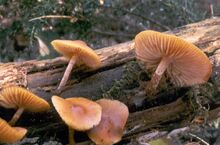Psilocybe cyanescens

Hunting psychoactive mushrooms in nature can be very dangerous.
Caution is advised because poisonous or deadly mushrooms can easily be mistaken for edible ones.
| Psilocybe cyanescens | |
|---|---|
|
P. cyanescens in nature. |
|
| Taxonomical nomenclature | |
| Kingdom | Fungi |
| Phylum | Basidiomycota |
| Class | Agaricomycetes |
| Order | Agaricales |
| Family | Hymenogastraceae |
| Genus | Psilocybe |
| Species | P. cyanescens |
| Common nomenclature | |
| Common names | Wavy caps, the potent Psilocybe |
| Mycological Characteristics | |
| Spore print | Purple-black |
| Edibility | Psychoactive |
| Constituents | |
| Active constituents | Psilocin, Psilocybin, Baeocystin, Norbaeocystin |
Psilocybe cyanescens is a potent psychedelic mushroom in the Psilocybe genus. The fruits of P. cyanescens have been shown to contain many different indole alkaloids including psilocybin, psilocin, and baeocystin.
Habitat and distribution
Psilocybe cyanescens grows today primarily on wood chips, especially in and along the perimeter of mulched plant beds in urban areas, but can also grow on other lignin-rich substrates. P. cyanescens does not grow on a substrate that is not lignin-rich. Fruitings have been reported in natural settings previously (although most appear to be migrations from mulched plant beds.) The species does not typically grow on mulch that is made from bark.
In the United States, P. cyanescens occurs mainly in the Pacific Northwest, south to the San Francisco Bay Area. It can also be found in areas such as Western Europe, Central Europe, New Zealand and parts of West Asia (Iran, Tehran). The range in which P. cyanescens occurs expands rapidly, especially in areas where it is not native as the use of mulch to control weeds has been popularized. This rapid expansion of range may be due in part to the simple expedient of P. cyanescens mycelium having colonized the distribution network of woodchip suppliers and thus being distributed on a large scale with commercial mulch.
Although it has been speculated that P. cyanescens' native habitat is the coniferous woodlands of the north-western United States or coastal dunes in the PNW, the type specimen was described from mulch beds in Kew Gardens, and there is no widely accepted explanation of P. cyanescens original habitat.
Fruiting is dependent on a drop in temperature. In the San Francisco Bay Area, this means that fruiting typically occurs between late October and February, and fruiting in other areas happens in fall when temperatures are between 10-18 °C (50-65 °F).
P. cyanescens often fruits gregariously or in cespitose clusters, sometimes in significant numbers. 100,000 P. cyanescens fruits were once found growing on a racetrack in the south of England. Solitary fruits are sometimes also found.
Similar species
Galerina marginata
Galerina marginata mushrooms are an extremely dangerous species which contain the same deadly amatoxins found in the death cap. They have similar habits and appearances, and the two mushrooms bear such a superficial resemblance to each other that new mushroom-seekers may confuse the two. The two species can grow side by side, which may add to the chance of confusion. This mushroom can cause death and severe liver damage as well as vomitting, diarrhea, and hypothermia if not quickly treated.
The size is roughly the same and the typical darkening at the base of the stem of Galerina species can be mistaken for the bluing reaction of Psilocybes. The spore colors are similar. Psilocybe species yield a purplish brown spore print versus the redder brown of a Galerina.[1]

